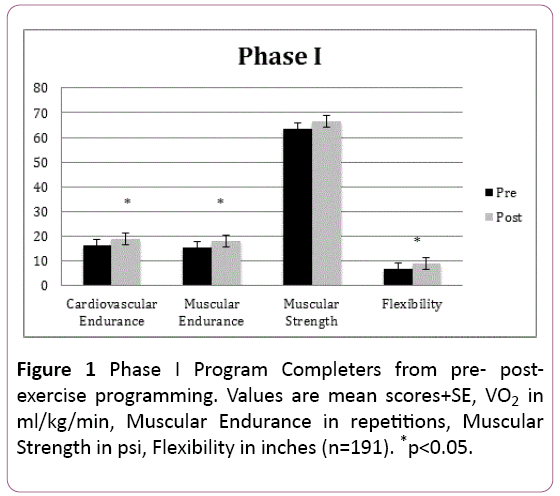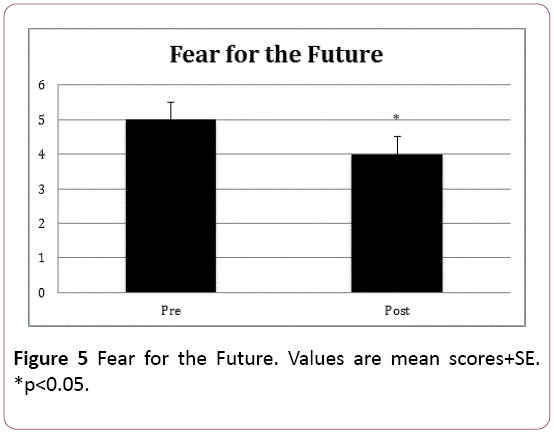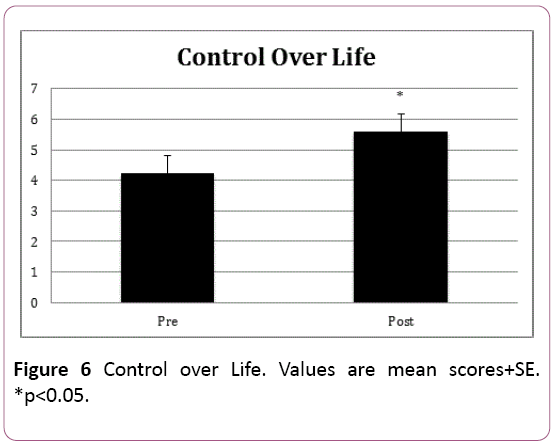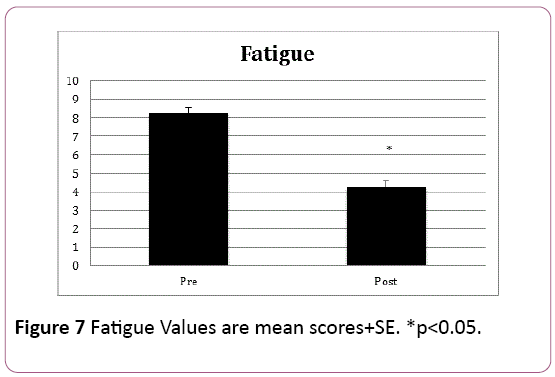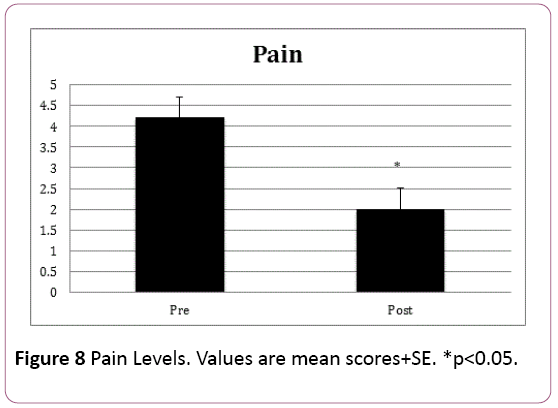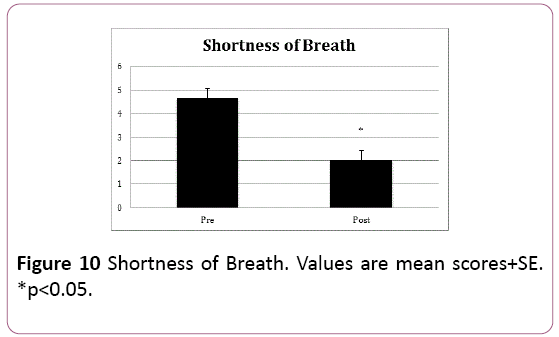Supervised, Individualized Exercise Mitigates Symptom Severity During Cancer Treatment
Karen Wonders, Rob Wise, Danielle Ondreka and Trent Seitz
Karen Wonders1,2*, Rob Wise2, Danielle Ondreka2 and Trent Seitz2
1Department of Kinesiology and Health, Wright State University, Dayton, USA
2Department of Nutrition, Maple Tree Cancer Alliance, Dayton, USA
- *Corresponding Author:
- Karen Wonders
Department of Kinesiology and Health
Wright State University, Dayton, USA
Tel: 2122432471
E-mail: karen.wonders@wright.edu
Received Date: December 26, 2017; Accepted Date: January 02, 2018; Published Date: January 09, 2018
Citation: Wonders K, Wise R, Ondreka D, Seitz T (2018) Supervised, Individualized Exercise Mitigates Symptom Severity During Cancer Treatment. J Adenocarcinoma & Osteosarcoma Vol 3 No.1:1.
Copyright: © 2018 Wonders K, et al. This is an open-access article distributed under the terms of the Creative Commons Attribution License, which permits unrestricted use, distribution, and reproduction in any medium, provided the original author and source are credited.
Abstract
Introduction: Early detection and advances in treatment options have contributed to a 13% decline in cancer mortality rates since the year 2004, leading to the classification of cancer as a chronic disease. This creates a challenge for health care providers to address the short and long-term effects of current cancer therapy and minimize toxicities. Therefore, the purpose of this investigation was to determine if exercise training during cancer treatment helped to minimize symptom severity during chemotherapy treatment.
Methods: This controlled trial evaluated the effects of individualized exercise therapy in 191 patients undergoing chemotherapy treatment. Study participants underwent standard prescribed chemotherapy schedules, and were excluded from the study if they had pre-existing cardiac, liver, and bone marrow conditions prior to treatment. Each participant completed the Edmonton Symptom Assessment System (ESAS-R) questionnaire, and a subjective symptom checklist to gauge the severity of treatment-related side effects related to chemotherapy at the start and conclusion of their treatment regimen. During their treatment, patients participated in a 12-week individualized, supervised exercise program through Maple Tree Cancer Alliance.
Results: Twelve weeks of supervised, individualized exercise had a positive impact on fitness parameters as well as symptom severity. Muscular strength, muscular endurance, and cardiovascular endurance significantly improved from baseline. In addition, overall quality of life, depression, sense of purpose, fear for the future, control over life, fatigue, pain, nausea, and shortness of breath all improved following the exercise intervention.
Conclusion: Twelve weeks of individualized exercise improved fitness parameters and mitigated symptoms during chemotherapy treatment.
Keywords
Cancer; Nausea; Chemotherapy treatment
Introduction
Early detection and advances in treatment options have contributed to a 13% decline in cancer mortality rates since the year 2004 [1]. At present, more than 15.5 million men and women are living today as cancer survivors [2]. This increase in cancer survivorship has led to the classification of cancer as a chronic disease [3]. Its associated treatments often result in long-term physical and psychological co-morbidities that negatively impact the cancer survivor's quality of life. This creates a challenge for health care providers to address the short and long-term effects of current cancer therapy and minimize toxicities [4].
Symptom distress is regarded as an important predictor of quality of life. Pain and fatigue are two of the most common symptoms experienced by individuals undergoing cancer treatment [5]. Between 68- 97% of patients report distressing levels of fatigue that interferes with their ability to perform activities of daily living [6]. Estimates of pain prevalence among cancer patients range from 14-100% [7]. Patients who experience pain tend to have more advanced disease [8]. Despite receiving curative cancer therapies, pain control remains inadequate approximately 42% of the time [9]. Other distress symptoms reported by cancer patients include depression, lack of energy, shortness of breath, difficultly sleeping, swelling, constipation, and dry mouth [10]. Most cancer patients report being affected by several of these symptoms concomitantly rather than in isolation, lending to exacerbated impairments to quality of life [11]. Treatments that target several symptoms at once are optimal in order to help patients thrive post-treatment. Exercise is a valid rehabilitative measure that can be introduced at any point along the cancer trajectory, and can successfully attenuate several symptoms that frequently cluster together. Therefore, the purpose of this investigation was to determine if exercise training during cancer treatment helped to minimize symptom severity during chemotherapy treatment.
Methods
Subjects
This controlled trial evaluated the effects of individualized exercise therapy in 191 patients undergoing chemotherapy treatment. Oncology patients who received cancer treatment at Kettering Medical Center in Dayton, Ohio between January – December 2017 participated in a cancer exercise program through Maple Tree Cancer Alliance, a non-profit organization that provides free exercise training to individuals battling cancer. The age range of the patients was 21-93 years. Study participants underwent standard prescribed chemotherapy schedules (cyclophosphamide, methotrexate, fluroracil, adriamycin, and cyclophosphamide). Patients were excluded from the study if they had pre-existing cardiac, liver, and bone marrow conditions prior to treatment.
Measures
At the initial visit, demographic information, medical history, and relevant clinical data were ascertained from all consenting participants. Patients then completed the Edmonton Symptom Assessment System (ESAS-R) questionnaire, as well as a subjective symptom checklist. These were used to gauge the severity of treatment-related side effects related to chemotherapy. The checklists consisted of 35 items of severity graded from “no” to “very severe” (0-10). These scales were previously evaluated in a similar cancer population [12] and measured the total number of symptoms experienced and mean severity score. Patients also underwent a comprehensive fitness assessment at this time. Cardiovascular fitness was measured via the Bruce treadmill test. Muscular strength was measured via hand grip dynamometer. Modified sit and reach measured flexibility. Muscular endurance was assessed via partial curl up test, and body composition was measured using skinfold calipers. Results from this fitness assessment were used to create an individualized exercise program that focused on each patient’s strengths and weaknesses.
Exercise training protocol
Each patient participated in a cancer exercise program through Maple Tree Cancer Alliance. All interested patients were referred by hospital oncologists, and began participation in the exercise program upon referral. They completed 12 weeks of prescribed, individualized exercise that included cardiovascular, strength training, and flexibility components during chemotherapy treatment. The intensity level for the cardiovascular exercise ranged from 30-45% of the individual’s predicted VO2 max. The strength training involved a full body workout, with emphasis on all major muscle groups. Machines, free weights, and tubing were all employed. Patients completed 3 sets of 10 repetitions for each exercise. Flexibility training involved static stretching of all major muscle groups for 15-20 seconds at the completion of each workout. Patients met with a trainer once a week and were given instructions on how to remain active at home. At the conclusion of this 12- week exercise program, patients underwent a follow-up reassessment and completed the ESAS-R) questionnaire and subjective symptom checklist again.
Statistical methods
Data were analyzed using Statistical Package for Social Sciences version 20.0 for PC windows 2000. Mean scores for measured symptom distress and fitness parameters were calculated for the complete sample. Since order of adjuvant treatment differed, an analysis of covariance (ANCOVA) was done to compare groups at each follow-up assessment using the baseline pre- chemotherapy measure as a covariate. A significance level of p<0.05 was used for all statistical analyses.
Results
A total of 191 patients currently undergoing cancer treatment completed the study. Table 1 presents patient demographics. Twelve weeks of supervised, individualized exercise had a positive impact on fitness parameters as well as symptom severity. Muscular strength, muscular endurance, and cardiovascular endurance significantly improved from baseline (p<0.05) (Figure 1). Individualized exercise also resulted in significant improvements to symptom severity, as presented in Figures 2-10.
| Average Age (years) | 60 + .05 | |
|---|---|---|
| Gender | ||
| Male | 16% | |
| Female | 84% | |
| Ethnicity | ||
| White | 74.69% | |
| African American | 10.23% | |
| Hispanic | 3.91% | |
| Asian | 5.67% | |
| Unknown | 4.39% | |
| Type of Cancer | ||
| Breast | 58.15% | |
| Colon | 4.49% | |
| Prostate | 1.97% | |
| Lung | 3.93% | |
| Leukemia | 0.28% | |
| Brain | 0.84% | |
| Multiple Myeloma | 2.25% |
Table 1: Presents patient demographics.
v
Discussion
Patients receiving cancer treatment have significant side effects that often interfere with their quality of life. The present study demonstrated that 12-weeks of supervised, individualized exercise resulted in a favorable improvement in symptom severity during cancer treatment. In a recent article, Stark and associates [9] recommend that attention should focus on evidence-based interventions to improve symptom distress for oncology patients, as the experience of symptom distress leads to depression and anxiety among cancer patients [13]. The findings of the present study confirm the efficacy of individualized exercise during cancer treatment on symptom improvement. The conditions of patients may rapidly deteriorate during treatment, causing symptoms to worsen suddenly and unexpectedly. Therefore, management of these symptoms is essential to improve quality of life and ensure adequate patient care.
Exercise is a promising intervention with the potential to mitigate multiple symptoms and improve physical functioning in cancer survivors. The role of exercise in moderating symptoms during cancer treatment may be influenced by its role in biological pathways involved in the etiology of many symptoms. Namely, the inflammatory immune responses involved in cell differentiation, cell proliferation, and apoptosis are involved with several negative symptoms related to chemotherapy treatment [14]. Yet, exercise has been shown to positively affect immune function [15]. Further, higher levels of sympathetic hormones are associated with fatigue, pain, depression, and fatigue [16]. However, a growing body of research strongly supports the role of exercise in positively influencing metabolic, genetic, and neuroendocrine function [15]. Most notably is fatigue, which is a common treatmentrelated side effect of treatment. Often, fatigue is most pronounced when pain is increased, and can remain elevated for up to two years post treatment. Often, fatigue contributes to a sedentary lifestyle, despite this and other studies that demonstrate improved energy following moderate physical activity [17,18]. Additionally, depression is experienced by 22-57% of cancer patients [19]. Depression scores are highest at diagnosis and during treatment [20], and can persist for 6 months following treatment [21]. In the current study, a 12- week exercise intervention improved depression scores in cancer patients. This is supported by previous, similar investigations [22].
Despite this and other investigations which have supported the efficacy of exercise during cancer treatment, nationally less than 5% of patients are ever referred to a cancer rehabilitation program [23]. Therefore, the authors of this investigation recommend a multidisciplinary team consisting of exercise physiologists, registered dietitians, social workers, physical therapists, occupational therapists, nurse practitioners, and physicians be created to monitor symptoms. A part of this would include an individualized exercise program. This will allow for adequate symptom management and promote the best possible patient care and treatment outcome for individuals battling cancer. Therefore, more specific research relating to a multi-disciplinary health care team to ensure adequate symptom management is warranted.
References
- American Cancer Society. Cancer Facts & Figures 2017. https://www.cancer.org/research/cancer-facts-statistics/all-cancer-facts-figures/cancer-facts-figures-2017.html
- ACS Report: Number of US Cancer Survivors Expected to Exceed 20 million by 2026. https://www.cancer.org/latest-news/report-number-of-cancer-survivors-continues-to-grow.html
- Lind J (1992). Tumor cell growth and cell kinetics. SemOncolNurs, 8(1): 3-9.
- National Institutes of Health. Cancer Costs Projected to reach at least $158 Billion in 2020. https://www.nih.gov/news-events/news-releases/cancer-costs-projected-reach-least-158-billion-2020
- Laird BJ, Scott AC, Colvin LA, McKeon AL, Murray GD, et al. (2011) Pain, depression and fatigue as a symptom cluster in advanced cancer. J Pain & Symptom Management 42: 1-1.
- Lawrence DP, Kupelnick B, Miller K, Devine D, Lau J, Evidence report on the occurrence, assessment, and treatment of fatigue in cancer patients. J Natl Cancer Inst Monogr. 2004; 32:40-50.
- Patrick D, Ferketich S, Frame PS, Harris JJ, Levin B, et al. (2004) National Institutes of Health state of the science conference statement: Symptom management in cancer: Pain, depression and fatigue. J Natl Cancer Inst Monogr 32: 9-16.
- Stark L, Tofthagen C, Visovsky C, McMillan SC (2012) The Symptom Experience of Patients with Cancer. J Hosp PalliatNurs 14: 61-70.
- Everdingen MH, Rijke JM, Kesselss AG, Schouten HC, Kleef VM, et al. (2007) High prevalence of pain in patients with cancer in a large population-based study in The Netherlands. Pain 132: 312-320.
- Benedetti C, Brock C, Cleeland C, Coyle N, Dube JE, et al. (2007) NCCN Practice Guidelines for Cancer Pain. Oncology 14: 135-150
- Sprod LK, Mohile SG, Wahnefried DW, Janelsins MC, Peppone LJ, et al. (2012) Exercise and Cancer Treatment Symptoms in 408 Newly Diagnosed Older Cancer Patients. J of geriatric oncol 3: 90-97.
- Wonders KY, Stout B, Ondreka D (2016) Group-based exercise improves fitness parameters in previously sedentary individuals with cancer. Int J of Innovative Medicine and Health Science 7: 12-16.
- Hou WK, Law CC, Fu YT (2010) Does change in positive affect mediate and/or moderate the impact of symptom distress in psychological adjustment after cancer diagnosis? A prospective analysis Psychology &Health 25: 417-431.
- Oltmanns U, Issa R, Sukkar MB, John M, Chung KF (2003) Role of c-jun N-terminal kinase in the induced release of GM-CSF, RANTES and IL-8 from human airway smooth muscle cells. British J of Pharmacology 139: 1228-1234.
- Koelwyn GJ, Wennerberg E, Demaria S, Jones LW (2015) Exercise in Regulation of Inflammation- Immune Axis Function in Cancer Initiation and Progression. Oncology 29
- Aligan LN, Olson K, Filler K, Larkin D, Cramp F, et al. (2015) The biology of cancer-related fatigue: a review of the literature. Supportive care in cancer: official j of Multinational Association of Supportive Care in Cancer 23: 2461-2478.
- Rogers LQ, Courneya KS, Robbins KT, Malone J, Seiz A, et al. (2006) Physical activity and quality of life in head and neck cancer survivors. Support Care Cancer 14: 1012-1129.
- Dimeo FC (2001) Effects of exercise on cancer-related fatigue.Cancer 92: 1689-1693.
- Zeller JL (2006) High suicide risk found for patients with head and neck cancer. JAMA 296: 1716-1717.
- Wolfe ME, Guire DB, Soeken K, Brown GJ, Forge BR (2009) Prevalence and correlates of depression among patients with head and neck cancer: a systematic review of implications for research. OncolNurs Forum 36: 107-125.
- Rhoten BA, Deng J, Dietrich MS, Murphy B, Ridner SH (2014) Body image and depressive symptoms in patients with head and neck cancer: an important relationship. Support Care Cancer 22: 3053-3060.
- Tomlinson D, Diorio C, Beyene J, Sung L (2014) Effect of exercise on cancer-related fatigue: a meta-analysis. Am J Phys Med Rehabil 93: 675-686.
- Smith SR, Zheng JY (2017) The Intersection of Oncology Prognosis and Cancer Rehabilitation. Curr Phys Med Rehabil Rep 5: 46-54.

Open Access Journals
- Aquaculture & Veterinary Science
- Chemistry & Chemical Sciences
- Clinical Sciences
- Engineering
- General Science
- Genetics & Molecular Biology
- Health Care & Nursing
- Immunology & Microbiology
- Materials Science
- Mathematics & Physics
- Medical Sciences
- Neurology & Psychiatry
- Oncology & Cancer Science
- Pharmaceutical Sciences
